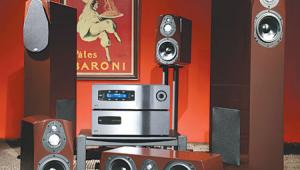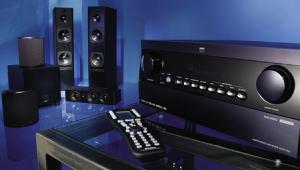Outlaw Audio Model 1070 A/V Receiver and Aperion Audio Intimus 532-LR Speaker System
Outlaw Audio and Aperion Audio both pursue the decidedly nonmainstream business model of selling quality surround gear directly to consumers over the Internet. Back when I worked for an Internet startup—don't fall asleep now, or I'll poke you with a stick—my now dead-as-a-doornail company caught a lot of flak for facilitating Internet sales of audio equipment. Isn't it unwise to buy something you haven't heard?

Well, if you lived in the best of all possible worlds, you could go into a store, listen to everything on the shelves, and come away with the best possible system for your needs at the best possible price. Sadly, unless you're lucky enough to live near a first-class A/V specialty store, you live in hell.
"Bookstores are terrible places to sell books," publishing guru Dan Poynter often says, and the same is true of chain stores designed to move massive quantities of mediocre electronics. I'll never forget the time I walked into one, overjoyed to find a dedicated demo room full of speakers—including one or two good specimens—only to find that all the tweeters had been punched in by malicious fingers.
There are still stores where the high-end audio flame burns bright, and brands—including some large and successful ones—that limit their distribution to such places. If you live near one, go there. But, if it's too long a drive or you're just used to buying over the Net, consider ordering this month's Spotlight System from Outlaw and Aperion. Hear for yourself how it sounds in your room with your favorite music and movies. Comparing this system to everything else I've reviewed over the past 15 years, I'd say this receiver-and-speaker-system combo is worth at least 50 percent more than what you'll pay, and I'm not trying to be effusive.
Warm-Hearted Renegade
Outlaw Audio's Model 1070 surround receiver succeeds the popular Model 1050 with significant updates in video switching, surround modes, and bass management, among other areas. It's one of the few receivers to include DVI video switching (two in, one out). Why DVI and not its successor, HDMI? Because DVI is a stable standard and HDMI is an evolving one. If you want to use this receiver with an HDMI-equipped device, an adapter will bridge the gap, and it might work—but a DVI-to-DVI connection is the only sure bet.
The power rating is another thing that distinguishes Outlaw as a stronghold of independent thinking. The 1070 is rated at 65 watts per channel (as opposed to a usually fictitious 100) with all seven channels driven (as opposed to one at a time). I can count the number of manufacturers who play fair with power ratings on the fingers of one hand, and this is one of them.
Tiny things that reviewers rarely mention add to this product's credibility. Crack the box, and you'll find the receiver sandwiched between two layers of nearly indestructible polyfoam—as opposed to the disintegrating styrofoam that comes apart in your hands (and during shipment). The slim spiral-bound instruction manual is written in clear, friendly, and endearingly paternalistic English. It's not only an exemplary manual but also a strong primer on surround sound in general.
The front panel is a round-cornered steel plate more than 0.25 inches thick, adding to the unit's above average (at this price) 40-pound weight. Well-chosen controls sprinkle it, including a set of navigation keys that allow you to punch in commands—in conjunction with the blue fluorescent front panel—as easily as you'd use the remote with the onscreen display.
An Outlaw exclusive resides on the rear panel—a three-position toggle switch that affects the 7.1-channel analog line input (the one you're likely to use with the line outputs of an SACD/
DVD-Audio player). The Digital mode applies the bass management and other choices you made in the main menu. In Bypass mode, the receiver applies no bass management at all, deferring to the disc player or other input source. Finally, the HPF/LPF mode applies a fixed 80-hertz analog crossover. The upside is that analog input signals remain in the analog domain, avoiding A-to-D and D-to-A conversions. The downside is the loss of other settings that you can only apply digitally, such as speaker size, distance, and the newly added lip-sync correction.
Outlaw has included the full panoply of Dolby Pro Logic II operations, including center-width, panorama, and dimension controls—features that appear too seldomly in other products. Given all of those genuinely helpful side-to-side and front-to-back adjustment options, there is no reason why anyone would need to use stereo for listening to music, although the receiver performs well in two-channel mode.
It performs well, in fact, in every mode. The character of the midrange is dead-on, neither softened nor hardened. It's not just a cartoon outline of a midrange but rather a fully nuanced, fleshed-out, and harmonically well-proportioned one. To get better performance, you'd have to resort to some very pricey separates. The point is, there's a lot you can do with 65 honest watts.
Towers of Power
The scent of flop sweat is familiar to anyone who loves music and buys new speakers. As you slit the packing tape, you feel like you're on a stage and that everyone is looking at you—even if you're alone in the room—and that they're thinking, "Did he blow it? Has he just made a jackass of himself?"
 That's why Aperion Audio's packaging panache may be more than mere eccentricity or bravado. Open up one of these boxes, pull off the (again nondisintegrating) foam, and what you see is not a naked speaker but a velvet bag in royal purple, tightened with a golden cord. Uncrating an Aperion is like unexpectedly stumbling into a coronation ceremony. And you can't help feeling you're the one being crowned.
That's why Aperion Audio's packaging panache may be more than mere eccentricity or bravado. Open up one of these boxes, pull off the (again nondisintegrating) foam, and what you see is not a naked speaker but a velvet bag in royal purple, tightened with a golden cord. Uncrating an Aperion is like unexpectedly stumbling into a coronation ceremony. And you can't help feeling you're the one being crowned.
If Outlaw's form of showmanship is nonconformist chic, Aperion's is pomp and circumstance, and the pleasant surprises continue when you finally confront the speakers themselves. My review system had a high-gloss-black finish (and, in the past, I've been equally impressed by the company's cherry veneer). Vinyl may be something you play through the system, but it's not something you have to look at every time you glance at your speakers.
The Intimus 532-LR is classed as a bookshelf speaker, although stands would give it a better chance to strut its stuff. I learned through youthful experimentation that, just as bookstores are terrible places to sell books, bookshelves are terrible places to put a bookshelf speaker. The simple two-way design hinges on Aperion's 1-inch silk-dome tweeter and 5.25-inch mineral-filled polypropylene woofer. This set of Aperions produced a huge soundfield that retained its composure at all but the most abusive volumes.
In the center position, the Intimus 533-VAC matches the 532-LR's woofer and tweeter, and it also has a 4-inch midrange driver and a passive radiator. While this adds a second crossover to the design, it also anchors voices incredibly well. I was playing around with language-lesson CDs while I was reviewing these speakers, and I quickly found that the center speaker did a far better job of delivering precise enunciation in a series of melodious European voices than the surround speakers operating in stereo. I also concluded that I'll never make it in Paris. Venice, maybe.
The Intimus 534-SS surround speaker switches to operate as either a bipole or a dipole. In bipole mode, the drivers on both sides of the triangular enclosure move in and out at the same time. In dipole mode, one side pushes while the other pulls, and, because dipoles operate out of phase, they generate more diffuse surround effects. Dipole is the preference in many THX systems, in surround mixing facilities, and at my place. I started House of Flying Daggers in bipole mode, but surround effects became distracting, and I switched to dipole halfway through.
Happy Together
I stood in front of my Boltz CD shelving like a kid in a candy store. What do you play through a system that partners a dead-accurate receiver with sweetly euphonic speakers? It's a bit like being a kid raised by a dad who urges you to be honest, strong, and independent, while Mom keeps slipping you cookies when he's not looking.
The Rolling Stones were cheating the reaper yet again when I was writing this review. I saw them 10 years ago during the Voodoo Lounge tour and got enthusiastic enough to buy the CD. The Aperions bathed the band in a golden haze—which is probably the best way to look at these guys—soft-focusing Charlie's high hat, smoothing out Mick's snarl, and rendering Keith's mighty strumming hand exactly as it should be—a rhythmic fist in a velvet glove.
Classical music is always on the menu at my place. Mozart's Complete Piano Trios, from the Mozartean Players, features a vintage fortepiano that cerebrally oriented gear tends to render as an impotent tinkle. In this case, it sounded slightly more like a forerunner of the modern piano; the equipment subtly added weight to the recording.
The flying-bean percussion scene in House of Flying Daggers gave the Outlaw a chance to demonstrate its dynamic oomph—and Aperion's S-12 sub a chance to pummel the room. In a world of high-excursion woofers and clever signal processing, this budget-priced 12-incher produces bass the old-fashioned way—with a monster enclosure. The receiver and speakers handily filled my 19-by-14-by-9-foot space with complex, reverberating information, and the subwoofer easily mastered the large space.
The system was capable of subtlety, too—especially toward the end of Crash, when Sandra Bullock embraces her much-abused housekeeper and says, sotto voce, that the older woman is her only friend. The center's midrange driver made the whispered words intelligible, and, to me, that's worth a hundred exploding cars.
Outlaw's Model 1070 is simply the best surround receiver I've found for less than $1,000. And Aperion's 532-LR speaker system backs up its deluxe appearance with sumptuous sound. This Spotlight System delivers the goods—warm heart, purple bag, and all.
Highlights
Outlaw Audio Model 1070 A/V Receiver:
• Best receiver I've found for less than $1,000
• The midrange doesn't play dumb
• Heir to the popular Model 1050
- Log in or register to post comments























































